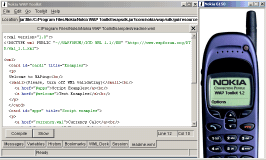
WAP
From the very first PDA column in issue 31, the biggest area of interest both for myself, and for readers, has been connectivity. The majority of my mailbag is about mobile Internet connectivity with infra-red mobile phones, followed by issues related to synchronisation. By and large, the synchronisation problem has been solved. Most PDA products can synchronise quickly and simply just by making a connection to a desktop machine. Larger scale mobile systems, both PC and otherwise, are still chasing after the grail of high quality Internet connectivity for email and for web browsing, but the root cause of the problem goes back to the mid-nineties.
When I first used the Internet, the two main areas that attracted me to it were email support, as strong then as now, and Usenet news. These days spam traps and newbies have forced me to abandon news for the more exclusive world of mailing lists. In those far off days of the early nineties, I used Archie and Gopher and WAIS; at the time, the World Wide Web was represented by only a few sites, and I used Tim Berners-Lee's own web browser, written for NeXTSTEP, and which wasn't available on any other platform. At the time, the big problem with the web was that there were so few sites providing content. A couple of years later, I set up my own experimental intranet, and set one up for a customer, but this was still the early nineties, and html was about content markup, not a bastard form of desktop publishing, and it was before the landmark
The net result of this is that a significant proportion of modern web sites cannot be effectively visited from a mobile device; even sites that are purportedly for mobile users. Only Psion and Windows CE support frames; none of them support JavaScript, Flash, RealAudio/RealVideo, etc. With HandWeb and Avantgo on Palm I often find sites that appear as a blank screen. If we forget for the moment about the minuscule world population of PDA users, there is a large population of many millions of mobile phone users that could benefit from some degree of web access, limited though it might be. The founders of the WAP (Wireless Application Protocol) Forum decided that it would be better to provide something that was optimised for these users and avoided the mistakes of html than to wait for the next best thing.
WAP (pronounced "whap" rather than "wop") is neither a superset nor a subset of html; rather, it is a related set of protocols optimised for wireless applications. It is XML based, and WAP applications are delivered to WAP browsers as precompiled, highly optimised bundles or "decks" of pages (cards, in WAP terminology). WAP includes both a markup language (WML) and a scripting language (WMLScript, akin to ECMAScript rather than JavaScript, but with the same general role).
Nokai WAP Toolkit

WML tags are similar to html, with < > around each tag; some, like and are in common. Each deck can contain several cards, each of which represents a different display. Menus and links can be used to navigate between cards and decks, or to execute specific scripts that can be bound up in a unit with the deck. In examples provided with Nokia's WAP Toolkit they cover standard currency converters and mortgage calculators.
The first WAP browsers are appearing already: Ericsson have supplied one with their MC218 EPOC32 machine, and there is one available for Palm (WAPman from http://www.virtuacom.com/wap); several phones are due to be launched with WAP browsers installed - the Nokia 7110, Motorola L7809, and many others. Palm themselves have licensed the WAP-like browser technology from Phone.com, who have been shipping not-quite-WAP products for some time. A number of companies are shipping custom servers for WAP, including Nokia and others; although a standard web server can be configured to serve WAP decks - however, a WAP gateway is required to access these services, which should be provided by the serive providers. Email portals are also now available (see http://www.ihub.com/infinite/wap/). All that is missing from the equation, as with the World Web Web earlier this decade, is content.
The only criticism of WAP would appear to be concerned with the lack of content; clearly corporate applications could break that barrier for specific areas. The CEO of Psion, David Levin, said that: "we ae not sure that there is any effective WAP provision [at this point]". Microsoft, although they are a member of the WAP Forum, are concentrating on their MicroBrowser, discussed at the 1999 Windows CE Developer Conference, which is a partial html browser optimised to run on 8 bit CPUs with four line displays - the classic American mobile phone. I think that WAP will, regardless of its adoption for content creation, become a standard part of the mobile phone service providers bag of services, rather like SMS, taking over as a form of paging system, with access to highly targetted services, like news, weather, stock quotes, etc.
http://www.wap.net
http://www.wapforum.org
http://www.nokia.com/corporate/wap/
http://www.phone.com
Words and design by:
Paul Lynch
Last updated: March 30, 1999